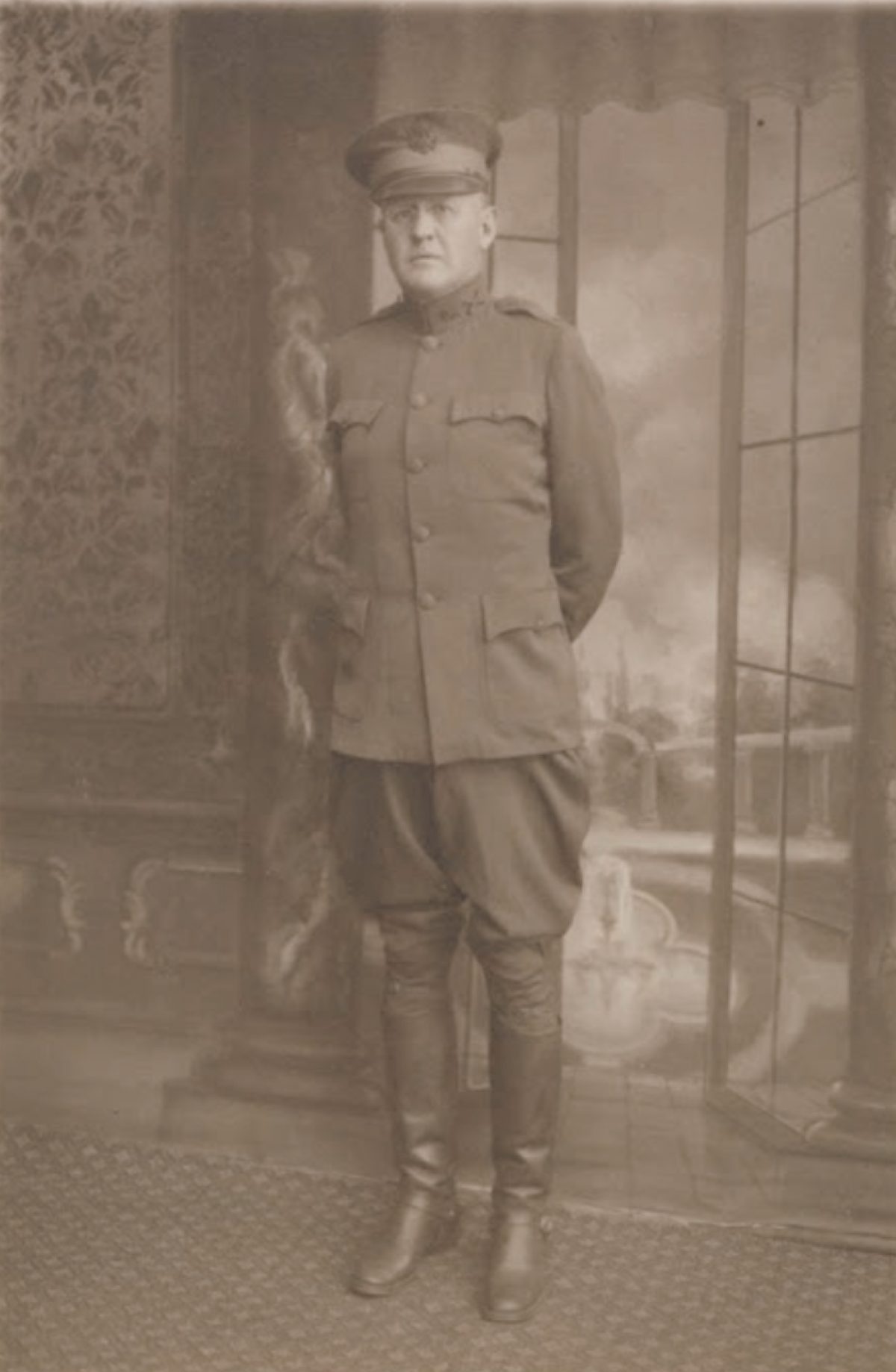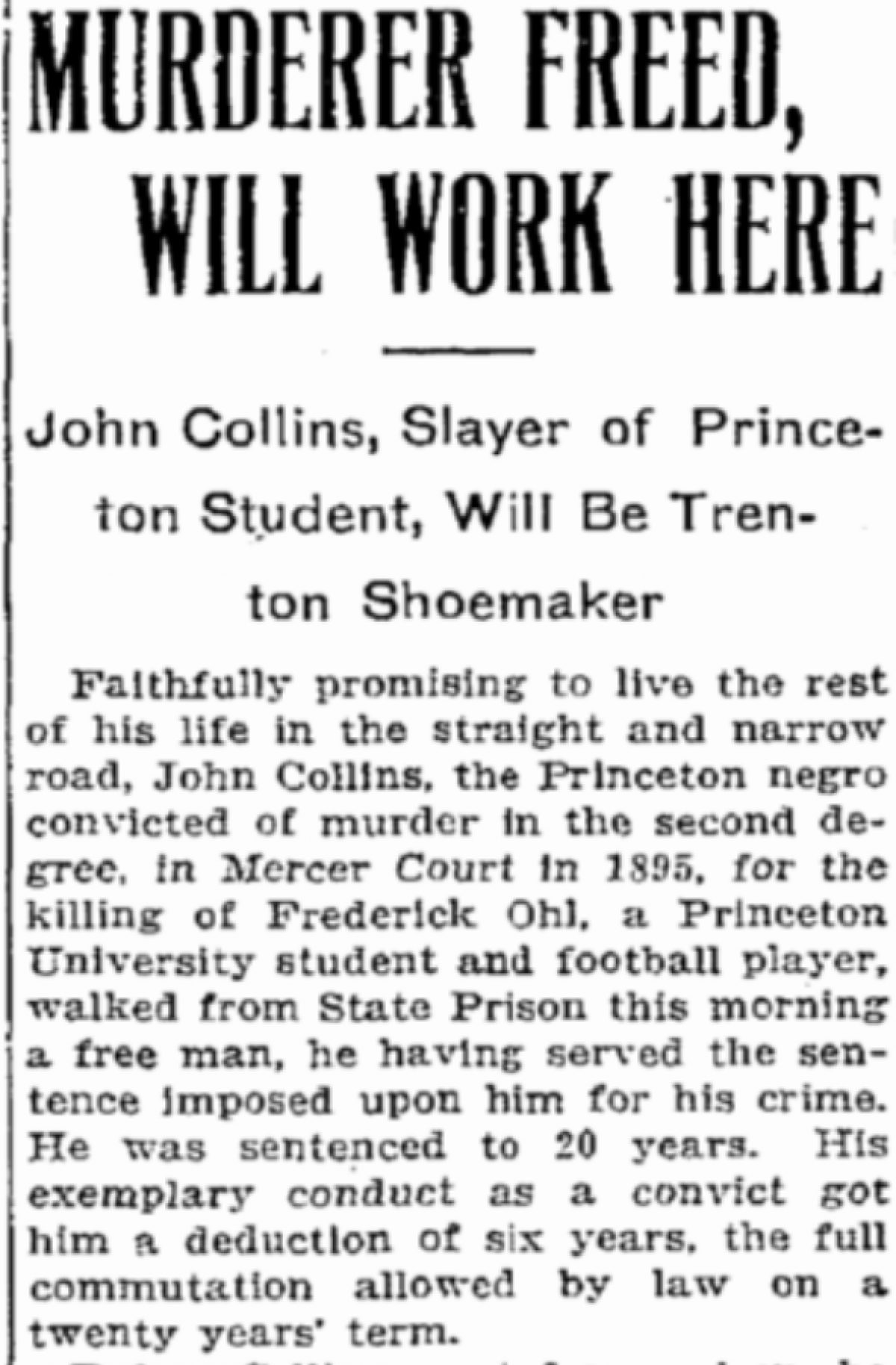Background
On the night of June 8, 1895, two white Princeton football players ventured out onto Nassau Street to meet up with friends. Later that evening, the two students were involved in an altercation with an African American man who fired three gunshots. Four days later, one of the students—Frederick Ohl—was dead.
Frederick “Fred” Ohl was a popular and promising Princeton freshman in the class of 1898. He’d been born in Sharon, Pennsylvania in 1875, son of Edwin O. Ohl, President of the Atlantic Iron and Steel Company and owner of several coal mines in Pennsylvania.[1] Before entering Princeton, Frederick Ohl had attended the public high school in Sharon and then the Kiskiminetas Springs Preparatory School (now known as the “Kiski School”), a private boarding school in Loyalhanna, Pennsylvania.[2] At Princeton, Ohl was well-liked among his peers and teachers alike, with a reputation as easy-tempered and hard-working. He was athletic, playing football in college as well as winning the heavyweight “Cane Rush” (a Princeton tradition that pitted freshmen against sophomores), taking the only cane won by a freshman that year.[3] One newspaper described him as “a total abstainer from drink and an orderly and close student.”[4]
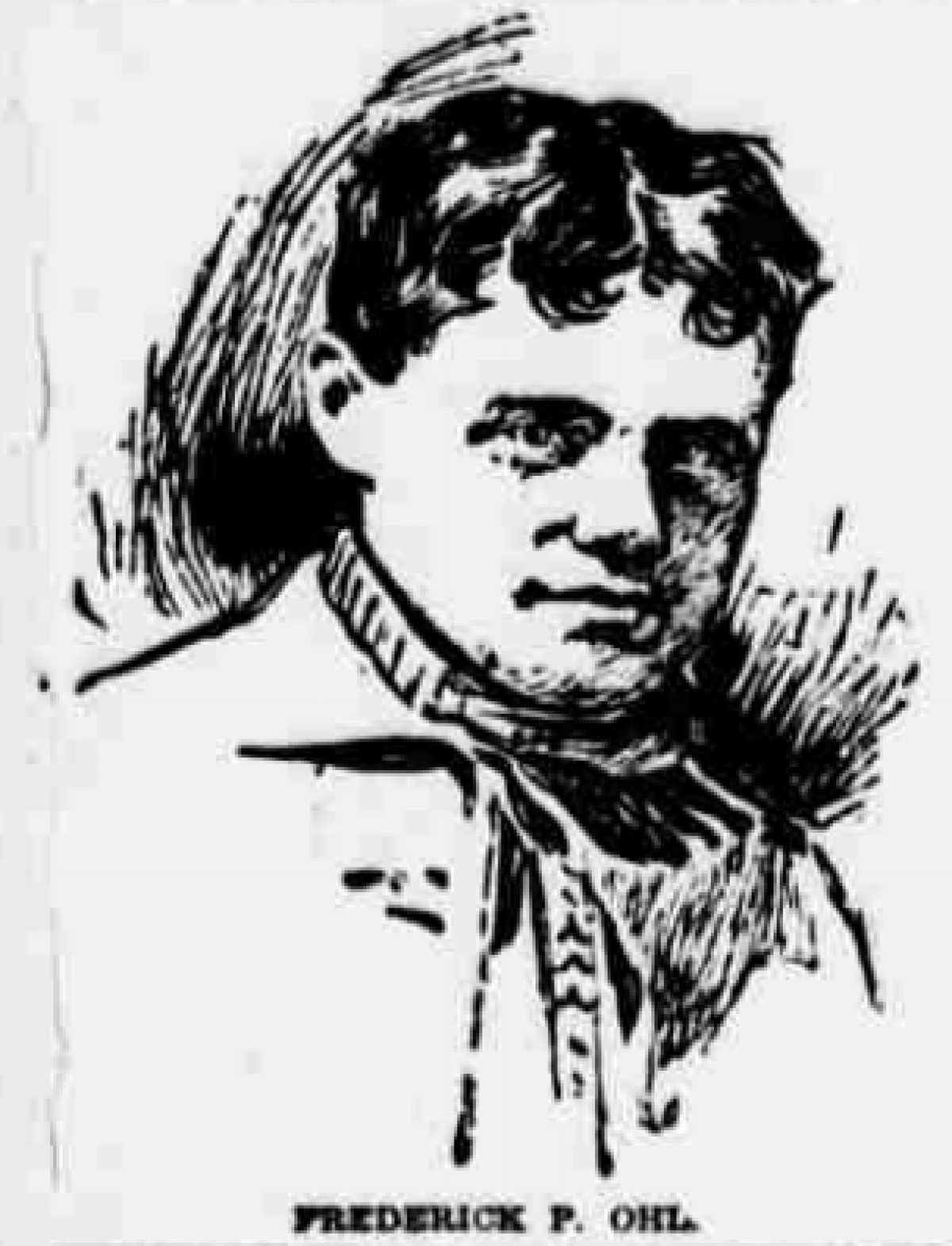
Sketch of Frederick P. Ohl, a Princeton student killed in an altercation with an African American man in 1895.
View Primary Sources
Ohl’s friend and Princeton football teammate, Garrett “Gary” Cochran (‘1897), sustained wounds in the 1895 altercation but survived. Born in Driftwood, Pennsylvania in 1876, Cochran also hailed from a wealthy and influential family. His father, Charles F. Cochran, made his fortune as a financier and later served as a Missouri state senator and member of the U.S. House of Representatives. A successful football player at Princeton—twice named “All-American” and captain of the team by his senior year—Cochran, like Ohl, proved very popular with his classmates, who named him “master of ceremonies” for his senior class.[5] Under his leadership, the Princeton football squad received the nickname “Cochran’s Steamrollers” and The New York Times proclaimed that “No name is better known in American football than that of Gary Cochran.”[6] Cochran attended the elite New Jersey boarding school Lawrenceville Academy before attending Princeton.[7]
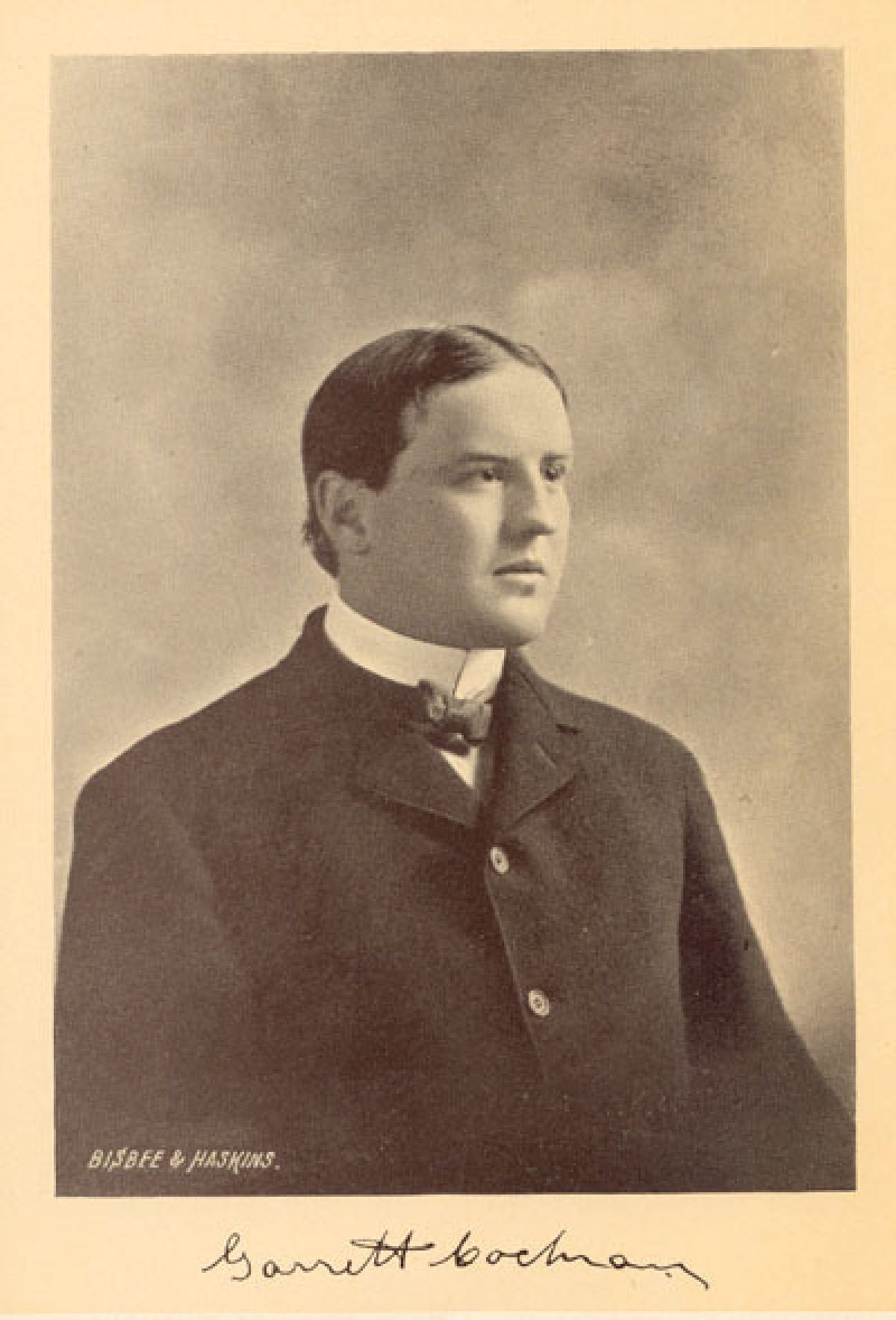
Photograph of Garrett Cochran (class of 1897), who survived the shooting that killed Ohl in 1895.
View Primary Sources
The life of John Collins, the African American man involved in the altercation, remains largely unknown. Approximately 26 years old in 1895, he lived in Princeton at the time of the incident and worked as a laborer for a local liveryman, Tom Lynch.[8] The Princeton Press described him in unflattering terms following the incident:
The man Collins is said to bear a bad reputation and to have been regarded as a dangerous man. His carrying of a concealed weapon was contrary to law and his reported reason for the purchase and possession of the pistol is unfavorable for his case.[9]
This article reflects the bias of the media outlets that documented this racially-charged incident. Yet while many newspaper reports painted Collins as a man of “bad character,” they also noted the way that the African American community in Princeton rallied around him, an indication of community solidarity and support.
June 8, 1895
A complex and tragic sequence of events led to the shooting of Ohl and Cochran, though reports of what exactly occurred lack clarity. As an article in the Indianapolis Journal put it:
The eyewitnesses of the affair have until today been reticent and no accurate account has been obtainable.[10]
The majority of the newspaper articles covering the incident presented the two Princeton students as “good-natured” bystanders, simply doing their best to defuse a violent situation and have a fun Saturday night. These same articles painted Collins as a violent, bad-tempered man and disregarded his claims of self-defense. The general inconsistencies of the stories and the favorable depiction of the two white men suggest that racial bias influenced the press coverage.
Despite significant discrepancies in accounts of what occurred, the following provides a plausible description of events:
On the afternoon of Saturday, June 8, Tom Lynch, a white man, fired John Collins from his job at Lynch’s lumber yard near Nassau Street in Princeton. The exact reasons for Collins’s termination are unknown, but he spent the remainder of the day stewing, in a state of despair.[11] That night, at around 10:00 PM, Collins took to the streets, stopping in at bars and telling people that he had plans to shoot someone.[12] Around the same time, Ohl and Cochran arrived downtown, kicking off their weekend. While numerous eyewitnesses stated that Collins appeared visibly drunk, newspapers reported that neither Ohl nor Cochran drank on the night in question. Ohl was allegedly a “strict teetotaller” and Cochran a man of “high character” who did not often get drunk.[13]
Ohl and Cochran heard Collins shouting while passing in front of Calhoun’s Bar and crossed the street to try to reason with him. Instead, they ended up getting into an argument in which the two parties exchanged racially-charged words. Ohl and Cochran did not come to blows with Collins at this time but left angrily. Following the initial encounter, Cochran and Ohl went to some neighborhood houses and armed themselves with fence palings (the planks that comprise a picket fence) to “protect themselves” from a future encounter with Collins.[14]
Later that night, Ohl and Cochran ran into Collins again in an alleyway outside of Anderson’s Hotel and Saloon.[15] Also known as “R.J. Anderson’s Restaurant,” the saloon, located at 126 Nassau Street, stood directly across from the Princeton campus.[16] When Collins began yelling at the students, Ohl and Cochran responded in kind. Collins then pulled out a pistol and fired three shots. The first shot hit Cochran in the jaw and the other two shots entered Ohl’s abdomen and wrist. While some newspapers reported that Stephen Downes, another Black man who worked with Collins, witnessed the shooting, Downes later denied being present when Collins fired.[17]
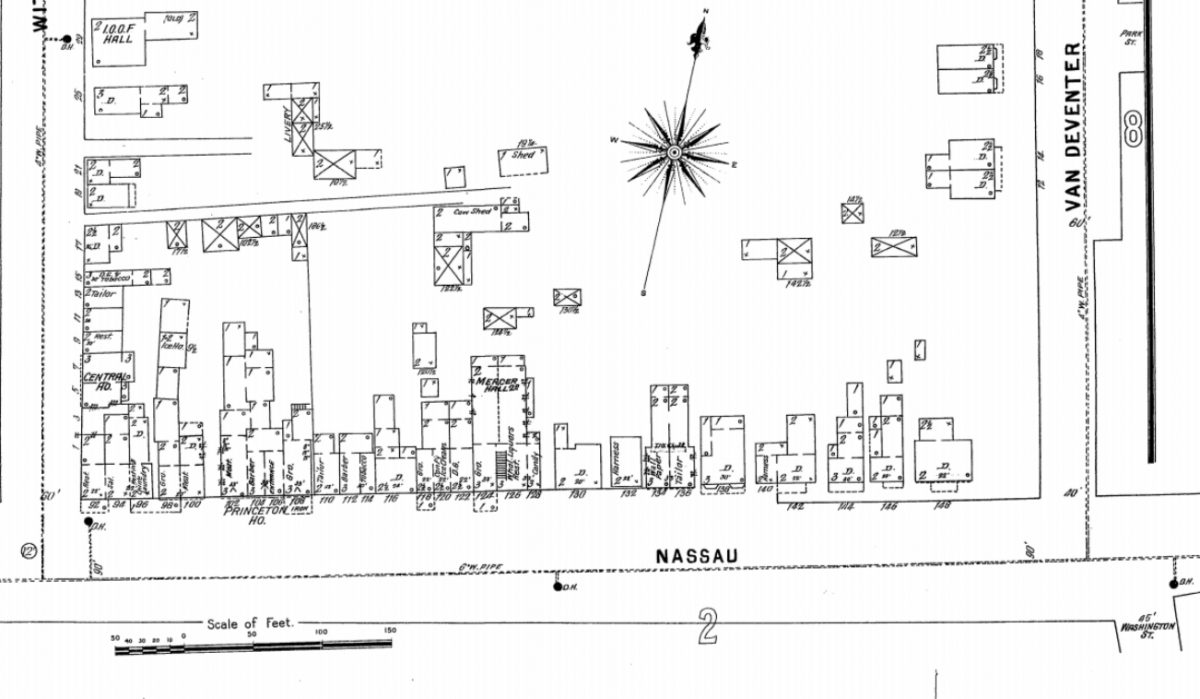
Map of Nassau Street in Princeton, including 126 Nassau Street, the saloon outside of which Frederick Ohl was shot in 1895.
View Primary Sources
Ultimately, both the press and local white residents painted Collins as a good-for-nothing troublemaker. Multiple news sources called the shooting “premeditated,” not self-defense or committed in the heat of the moment, because Ohl bore a striking resemblance to a student in the Princeton class of 1896 with whom Collins had had an altercation only a week prior to the shooting. Local lore suggested that Collins always carried a pistol and even slept with it under his pillow. One newspaper quoted Collins bragging: “If anyone bothers me I will bore a hole through him.”[18]
Collins later claimed that he fired at the boys in an act of self-defense. Collins asserted that the boys had harassed him all night, and said that when they met at Anderson’s the boys carried fence palings and shouted threatening racial slurs at him. Other witnesses reported that the boys held nothing their hands.[19] Because Collins confessed to shooting the boys, his guilt or innocence depended on his self-defense claim. The white media largely suppressed the alternative narrative of the Princeton students as the instigators and aggressors. Given the differing accounts and possibility of racial bias, it seems prudent to consider both narratives.
The accounts of numerous witnesses who were present or “nearby” when the altercation occurred offer more questions than answers. Stephen Downes, Collins’ friend and companion on the night in question, was the most reliable eyewitness. According to one source, Downes completely corroborated Collins’s story, though in later court testimony he claimed he did not see the actual shooting.[20]
Another witness, Charles R. Lawrence (a white man), reported:
A little after 10 o’clock, as I was walking down the street, I heard two shots and saw a crowd rush toward the place then saw a crowd come out of the hallway. I recognized Cochran in the crowd and heard him shout, ‘This man shot us both, don’t let him shoot again.’[21]
John N. Thompson, also a white man, said that he saw Collins pull a pistol on the boys prior to the shooting, saying that “he would lick them” if they gave him any more trouble. Thompson then asserted that he saw the boys “break a fence paling in two parts and each take a part.” When they arrived at Anderson’s saloon, he heard “the colored man call a vile name and asked the boys to step inside and he would ‘do them.’”[22]
Thompson’s version of events seemed to validate both Collins’s claim of self-defense and also Cochran’s assertion of Collins’s drunkenness. The fact that media outlets largely ignored this more balanced narrative suggests a combination of inaccuracy, incompetence, and racial bias.
The Princeton Press’s account of the incident highlighted the role that alcohol played in the shooting. The article emphasized Ohl and Collins’ sobriety and Collins’s drunkenness stating: “….there is hardly a serious crime in the history of the town but is someway mixed up with the pernicious saloon.” The newspaper’s commentary on drink foreshadows a society on the brink of the Prohibition era.[23]
Another contemporary account, a heavily annotated newspaper clipping found in the scrapbook of Louis Irving Reichner (‘1894) described events slightly differently. The article centered the blame for the incident almost entirely on Collins, but also featured voices from Princeton’s African American community, who stated:
Whenever a crowd of students feel gay the first thing they think of is finding a colored man and thrashing him.[24]
The article characterized Cochran and Ohl as “thirsting for blood” on the night in question and suggested the presence of racial tensions in Princeton due to harassment of local African Americans by Princeton students. While Reichner’s annotations suggest he favored the prevailing view that the incident was Collins’s fault, the clipping provides an alternative side of the narrative not addressed in other press coverage.
Later in life, Reichner would go on to open a law firm in Philadelphia, and both his son and grandson would attend Princeton. Little is known about his connection to Cochran and Ohl, but the fact that he chose to place an annotated account about the incident in his scrapbook suggests the shooting was seminal event for Princeton students of that era.
Death of Ohl
News of the shooting spread quickly through Princeton. Police arrested Collins and took him to a jail in Trenton—though, interestingly, they never located the pistol used to perpetrate the crime.[25] Numerous sources suggested that, had the sheriff not immediately taken Collins to Trenton, angry Princeton students who “battered in the door of the jail in search of Collins and his companion” would have lynched him.[26] The Baltimore Sun agreed, reporting that “had it not been for some cool heads and a speech from Colonel McCook there might have been a lynching.”[27] As another newspaper wrote:
Lynch law administered by the students of an American college would have given the cause of a higher education in this country a very black eye.[28]
This was not the first time Princeton students had engaged in extralegal justice. Since the antebellum period, Princeton students had shown a tendency to give in to racially-motivated violence. In 1835, students threatened to lynch a white abolitionist holding a meeting in the local Black neighborhood. In 1846, a mob of southern-born students beat and nearly killed an African American man who had confronted two white college boys.
In 1895, unlike before the Civil War, the majority of the student body hailed from the North. Nevertheless, the college community maintained a state of race relations so tense that white students and residents felt vindicated in pursuing vigilante justice. The students’ actions in 1895 speak not only to the to the lack of progress Princeton had made since the end of the Civil War, but also the growing influence of Jim Crow culture throughout the nation.
Two days after the incident, although the condition of both Ohl and Cochran remained critical, doctors agreed they both had a good chance of recovering.[29] The day of the shooting, a college student had used a telephone (a relatively recent invention) to call on the best doctors in New York. Dr. Myron T. Denton and Dr. W. T. Bull, both based in New York, traveled to Princeton to treat the students. They extracted the bullets from Ohl’s body but failed to remove the bullet lodged in Cochran’s jaw.[30] Both men were optimistic that the athleticism of the injured boys would aid in their recovery and survival.
The doctors also asserted that the location and extent of Ohl’s wounds indicated that he tried to draw away or protect Cochran when the shooting took place—evidence that they believed proved the boys were innocent bystanders, not the perpetrators of violence. One doctor claimed:
There is strong circumstantial evidence that the student who suffered most severely was innocent of any wrong. This seems to prove indisputably that Ohl was behind his companion and probably with his hand upon his shoulder attempting to rescue him.[31]
Despite an initially positive prognosis, at 4:00 AM on Wednesday, June 12, Frederick Ohl died of peritonitis (inflammation of the abdominal wall) in the Isabella McCosh infirmary.[32] His condition had worsened overnight, and he contracted a high fever and passed away. Multiple Princeton doctors had tried various remedies to save his life, but they could not rouse him, even to say a final goodbye. Ohl died at age 19, unconscious of his surroundings and surrounded by friends, family, and teachers.[33]
News of Ohl’s death spread rapidly across campus, outraging students and faculty alike. Dean James Murray and President William Potter issued condolences to the boy’s family and committed to take swift action to avenge their deaths. Dean Murray noted that Ohl had “promised to be a bright and good student and the college had lost a good man.” He also attested to the sobriety of both Ohl and Cochran on the night in question, saying “that the habits and character of both men are excellent. Cochran is not a drinking man and Ohl is a total abstainer.”[34] The Princeton Press also eulogized Ohl:
During the years of his connection with Princeton College he won the healthy respect of his teachers and the regard of his classmates by his manly and attractive qualities. His open-hearted, genuine disposition won him close friends, and the more he became known to the college at large the more he was esteemed and beloved.[35]
The freshman class elected two representatives, Joseph Hutchinson of Philadelphia and Oliver Jackson of Newark, to accompany Ohl’s remains to his final resting place in Pennsylvania. Ohl’s classmates also bought flowers for his grieving family. Ohl had passed away on the day of commencement ceremonies, casting a dark cloud over the festivities of the graduating class.[36] At 11:00 AM on the day of his death, Ohl’s classmates convened a meeting and issued a remembrance in honor of Ohl, stating “That we, as a class, mourn the loss of one of our number, and wish to bear testimony to his upright and honorable character while associated with us at Princeton.”[37]
Senator Cochran, Garrett Cochran’s father, also issued a statement:
There are many stories afloat as to how the shooting occurred, but from the general evidence and from young Ohl’s excellent character it would seem that Collins must certainly have been the aggressor.[38]
While largely absent from the historical retelling of the incident, Collins reacted with shock and horror at the news of Ohl’s death, proclaiming in a trembling voice:
I did not mean to hurt him. They made me shoot or they would have killed me.[39]
The "Negro Boycott"
On Princeton’s campus, news of Ohl’s death aroused intense sadness. This sadness quickly turned to anger and resentment, and throughout the day small groups of students met around campus to discuss the possibility of “taking action.” Later, a larger group of students met to “take action,” most likely intending to form a lynch mob. Ultimately, the students decided that such a plan would be too difficult to carry out (as Collins was already in jail in Trenton) and worried that vigilante justice and additional violence would only make the situation more difficult for Ohl’s family.[40]
Instead of violence, students decided to implement a “boycott of all negroes.” As in the antebellum period, African Americans comprised a large number of college employees working on campus as baggage handlers, at eating clubs, or in other service positions. In order to limit the economic opportunity for a population dependent on employment provided by the college, students devised a plan that they would “employ no negro” who had not resided in Princeton at least three years, except for those already employed for a year who had proven themselves “acceptable.” The students believed that the “adoption of a boycott of this kind would force the greater part of the colored population out of this place.”[41]
A survey of archival materials, historical newspapers, and alumni notes from the year of the shooting and the following fall semester provide no indication that students ever fully organized or executed such a boycott. The sense of anger and excitement likely died down as students went home for the summer. The mere discussion of such a boycott, however, speaks to lingering tensions on Princeton’s campus as the country ushered in an era of Jim Crow. Princeton students were fully willing to use their resources and influence to demean, discriminate, and diminish the local African American community.
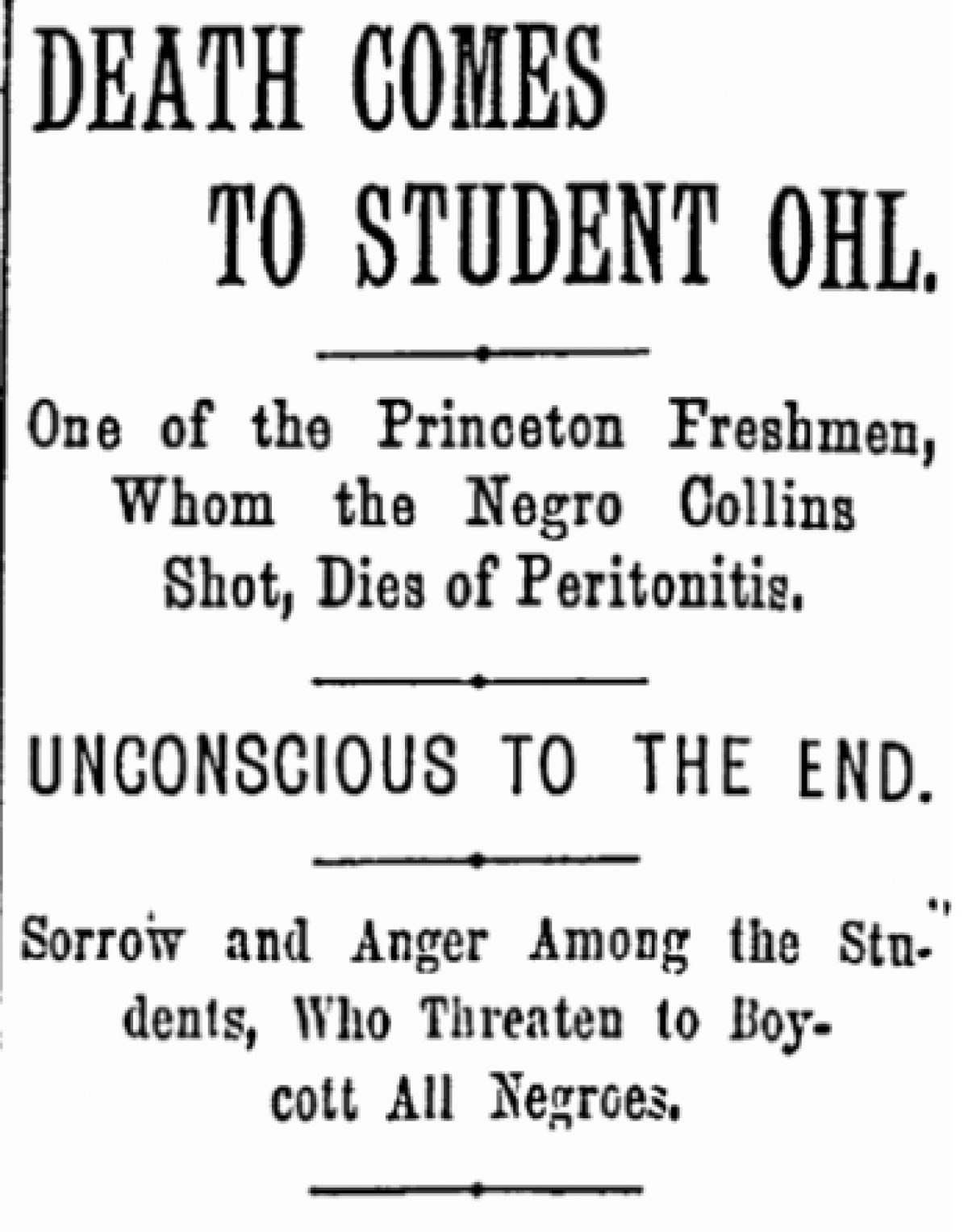
Newspaper article describing Princeton students' plans to "boycott" African American laborers in town after the death of classmate Frederick Ohl in 1895.
View Primary Sources
Trial of Collins
On June 13, a day after Ohl’s death, officials in Trenton conducted an inquest into the shooting. Officials took testimony from Coroner Bowers of Trenton, doctors, and individuals near the incident when it occurred. Almost immediately after the inquest, prosecutors presented the case to a Mercer County Grand Jury in district court in Trenton. The charge against Collins alleged that “Fred P. Ohl came to his death from a bullet wound inflicted by a pistol in the hands of and fired by John Collins.”[42] Prosecutors also brought charges for the assault of Garrett Cochran. It remains unclear whether Collins secured counsel prior to the grand jury hearing. For his subsequent trial, however, members of the Black community in Trenton raised money to provide him with an adequate defense. Three Irish-American defense attorneys comprised Collins’ legal team: Chauncy Beasley and John L. Conrad of Trenton, and William D. Daley of Jersey City.[43]
On June 15, the Mercer County District Court arraigned Collins, with members of the African American community and Princeton students crowding the courtroom. Collins’s counsel tried to quash the indictment by claiming that it had not been drafted in accordance with New Jersey common law. The judge denied the defense’s motion, setting a date for a trial in the following month.[44]
Widely covered by local and national media, the trial began on July 16, generating intense public interest and becoming a popular spectacle among local “society ladies.” Bayard Stockton, a successful New Jersey prosecutor, tried the case and pressed for a conviction of Collins on a charge of first-degree murder, a sentence that carried the death penalty. The media supported Stockton’s strategy. One report indicated that Senator Cochran had “investigated the story that his son and young Ohl first attacked Collins with fence rails and failed to find any evidence to support his story.” He denounced the shooting of Ohl as a “willful murder.” In the lead-up to the trial, Collins consistently claimed that the boys approached him first, and while few observers saw the boys as the aggressors, some opined that they should not have engaged with Collins earlier in the night or later at the saloon.[45] Prior to and during the trial, prosecutors omitted any suggestion that the boys might share some of the blame for the events that transpired.
On the opening day of the trial, the prosecution called Garrett Cochran to testify. Cochran testified in a mild, timid manner, a large scar angling across his face. The prosecution reinforced the narrative of the students as innocent bystanders to a violent crime. Cochran testified that at the beginning of the night he and Ohl had gone into town with another football player, John Scott, to talk about the “ballgame.” They planned to meet up with a group of about twenty other students at Anderson’s Saloon to talk, drink, and unwind. Cochran testified that in the first encounter on June 8, a drunk and violent Collins made threats and challenged them to fight. In response to Collins’ aggressive demeanor, Ohl reportedly yelled, “We don’t want to fight with you fellows,” referring to Collins and his friend Downes.[46]
Cochran stated that before arriving at Anderson’s Saloon he had a single beer at about 8:00 PM and that Ohl consumed no alcohol because he “never drank.” When the pair arrived at Anderson’s Saloon to meet up with their friends, Cochran said he heard Collins shout, “Come in here you white —.” Collins pulled them into the alleyway, where he pulled out his pistol. Ohl lunged for the pistol and Collins shot him. Cochran eventually grabbed the revolver, but not before a bullet entered his jaw.[47]
Cochran further testified that after their first encounter with Collins, he and Ohl had grabbed fence palings to “defend themselves against future attacks.”[48] The defense attorneys pressed Cochran on this, asking why, if they feared for their lives and truly desired a peaceful night out, they had not simply gone home or at the very least forgone the fence palings. Cochran asserted that despite the fact that the boys had no intention of attacking Collins they feared he might attack them, which is why they grabbed the palings. As to why they didn’t just go home, Cochran lacked a good answer.
Cochran’s testimony that he and Ohl had grabbed fence palings following their initial encounter with Collins lends credence to Collins’ self-defense narrative. If they lacked violent intentions, it seems unlikely that the students would have gone to the trouble of grabbing the fence palings to protect themselves against a hypothetical attack when it would have been much easier to simply go home. Collins could have reasonably interpreted their possession of the palings as an act of aggression.
The defense called several witnesses. Stephen Downes, the acquaintance of Collins who had been with him on the night in question, provided the main testimony in support of Collins. Downes claimed that at the first encounter with Ohl and Cochran, early in the night, Collins had asked politely, “What do you fellows want?” According to Downes, the students moved aggressively towards Collins and shouted, “If we had you Niggers down south we would Lynch you.” Downes also testified that while he did not witness the shooting itself, he heard a scuffle between Collins and the students prior to the shots. Following Downes, the defense called Dr. Dickinson, the doctor who had examined Collins in jail immediately following the shooting. The doctor testified that he had observed fresh scrapes and bruises on Collins following the shooting that conceivably could have come from an attack by the boys.[49]
The defense then put Collins on the witness stand. Although Collins had confessed to the shooting immediately after his arrest, the judge blocked the confession from evidence because when giving the statement Collins had not understood that it could be used against him. Collins’s version of events differed little from that of Downes and focused on self-defense. Collins added the detail that, when he first encountered the students that night, they had accosted him, yelling “What is the matter with you nigger.” When one of the students grabbed him he shouted, “Leave go of me. I haven’t done anything.” Collins then offered to fight the students but Downes pulled him back and the two parties separated until the later encounter, when the shooting occurred. According to Collins, he only shot his pistol after Ohl hit him with fence palings, and when they hit him again he then shot at the boys twice more.[50]
John Thompson, who ran a boarding house for students in town, also testified. He had been sitting on his porch near the scene of the murder. He reportedly heard one of the students yell (before arriving at Anderson’s), “Put away that pistol and I can whip you.” According to Thompson, Collins then took off his coat and wanted to fight, but Downes restrained him. Although Thompson testified that he could not see the individual faces of Ohl, Cochran, or Collins, Thompson then asserted that one of the students yelled to his companion, “You don’t want to fight a nigger with a pistol.”[51]
The jury originally split when it came to deciding on what charge to convict John Collins, with several jurors accepting Collins’s self-defense argument. On the jury’s first ballot, seven jurors voted in favor of first-degree murder and five voted for a charge of manslaughter. On the second ballot, eight jurors voted for a first degree murder charge and four for manslaughter. Not until the third ballot did jurors agree on a compromise guilty verdict for second-degree murder (a step up from manslaughter but below first-degree murder).[52]
The trial came to an end on July 24, 1895, forty-six days after the shooting, when John Collins received a sentence of twenty years’ hard labor in the New Jersey State Prison. One New Jersey paper reported: “Collins was called to the bar as soon as court opened this morning. The negro appeared to be in a happy state of mind, and was smiling when called.” Collins entered a plea of non vult contendere, meaning that the defendant was unwilling to admit guilt but was willing to submit to the court for sentencing. He received the maximum sentence for second-degree murder, twenty years, and an additional ten years for the assault of Garrett Cochran, to be served concurrently with the twenty-year sentence. Collins reportedly smiled during the sentencing and laughed as officials led him from the courtroom.[53]
On July 28, officials transferred Collins from Trenton’s local jail to the New Jersey State Prison. Newspaper coverage of the transfer portrayed Collins in a stereotypical manner, presenting him as a docile Black man unaffected by the seriousness of his crime—though during the trial, he had been stereotyped differently, as a violent, drunken aggressor. The article stated:
The prisoner was not at all disconcerted and chatted freely with several persons who stood nearby when he entered the prison. His manner was pleasant and he smiled while enduring the testing to which every new arrival is subjected.[54]
The article also noted that Collins was one of ten men from Mercer County serving sentences in the New Jersey State Prison for murder. Of those ten, Collins was the only Black man.
Historical Context
The shooting and trial aroused strong feelings of anger and resentment on the Princeton campus, speaking not only to Ohl and Cochran’s popularity but also to existing racial tensions and the long history of Princeton students responding passionately (and violently) to issues involving race.
Although no evidence exists of other violent events related to race around the time of the 1895 shooting, racism remained an integral part of the university and local community throughout the period. Minstrel shows, which often employed offensive racial parody and blackface to express nostalgia for slavery, became popular at Princeton following the Civil War, giving students an outlet for “pent-up humorous and jocular emotions.”[55] The shows, which portrayed African Americans as lazy, stupid, and vain order to entertain white audiences, remained popular on Princeton campus until the mid-20th century. This interest in minstrelsy indicates the continued racial stereotyping long present on Princeton campus.
The presence of African American students at the Princeton Theological Seminary as well as Princeton’s graduate school around the time of the shooting added to the complex racial dynamic of this case. At that time, Princeton administrators based admission to graduate programs entirely on the discretion of individual professors, so despite the fact that Princeton as an undergraduate institution did not accept Black students, the graduate school could and did.
Also, students enrolled at the Princeton Theological Seminary, which did accept Black students, could take a class at Princeton and earn a Master’s degree. Abraham Parker Denny and James Monroe Boger earned Master’s degrees in 1891 and 1893, respectively.[56] In 1898, both men joined activists in Princeton in calling on U.S. President William McKinley and Congress to pass laws ending the epidemic of lynchings across the country. Reverend I.W.L. Roundtree, the only known Princeton graduate to have been born into slavery, received a Master of Art degree in 1895. He would go on to study at Oxford and become a prominent New Jersey advocate for racial equality.[57] At the same time, Alexander Dumas Watkins conducted scientific research at Princeton and served as the school's first Black instructor.
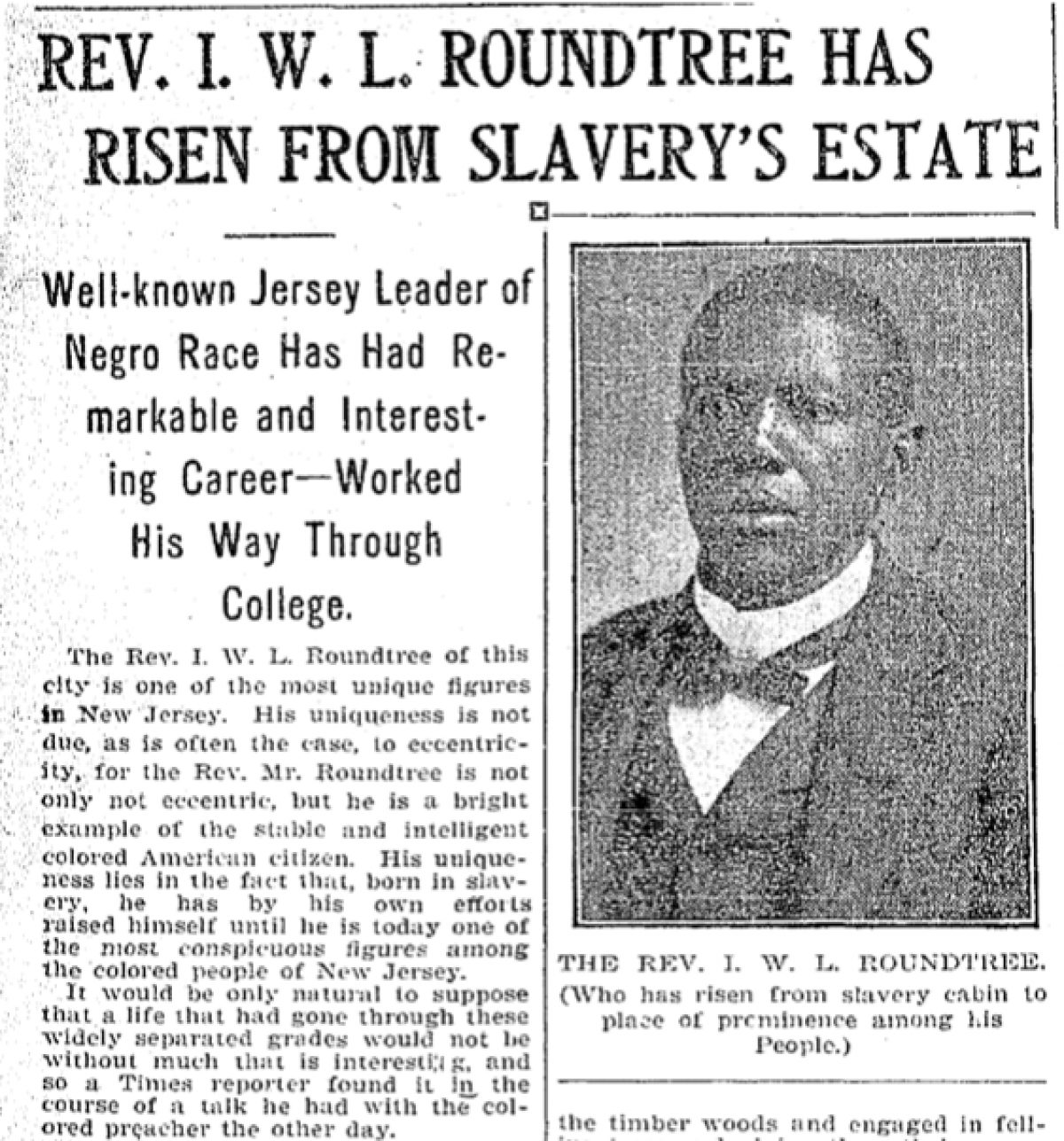
Profile of I. W. L. Roundtree, a late-19th century Princeton graduate who was born a slave.
View Primary Sources
These men’s presence at Princeton and receipt of graduate degrees represented meaningful progress towards racial diversity at Princeton, and Denny, Boger, and Roundtree all later served as leaders in the African American communities of Princeton and New Jersey. However, by the time Woodrow Wilson became Princeton’s president in 1902, their individual accomplishments and the symbolic progress they represented were largely forgotten. Wilson and his contemporaries erased the role that Black graduate students played in Princeton’s history. According to one biographer, Wilson’s vision of Princeton’s future had no place for African Americans, “whom he wrote off as a race incapable of achieving greatness.”[58] As a result, Princeton did not begin the process of fully integrating both its graduate and undergraduate student populations until after World War II.
Afterlives
For Garrett Cochran, who survived the fatal shooting, football remained a key part of his life.[59] After graduating from Princeton, the University of California-Berkeley recruited him, at age 22, to be the head coach of their fledgling football team. While he only coached the team for two seasons, he helped bring it to national prominence with two big victories over the nationally renowned Stanford team. He then went on to coach the U.S. Naval Academy football team in 1900, and in 1902 took over as head coach of the Princeton football team. In 1971, the College Football Hall of Fame posthumously recognized him for his accomplishments as a player and coach. Towards the end of his career, he served as the President and General Manager of the Williamsport Wire and Rope Company. He married Eleanor McNeely and the couple had three boys, all of whom attended Lawrenceville Academy and Princeton.[60]
When the “Great War” broke out, Cochran enlisted in the U.S. Army and fought in France, serving as a Lieutenant in Field Artillery.[61] On July 8, 1918, at age 42, he died from pneumonia while traveling back to the United States. Following his death, the Princeton Alumni Weekly issued this remembrance: “Enlistment in the service of his country was the natural outgrowth of his life and feeling. He was always a close student of military tactics, well read, particularly Napoleonic campaigns being able to tell - as he frequently did - the full story of the Battle of Waterloo.”[62] Cochran’s family as well as Princeton community members remembered him as a war hero, with the role he played in the 1895 altercation largely forgotten. He was buried at Trinity Episcopal Church in Williamsport, Pennsylvania on Friday July 26, 1918.[63]
John Collins secured release for “good behavior” from the New Jersey State Prison on October 16, 1909, after serving fourteen years of his twenty year sentence. Following his release, the Trenton Times wrote a surprisingly laudatory article about Collins and his transformation while in prison. The article quoted his state probation officer, Henry K. Straley, who called Collins one of “the best prisoners the institution had ever seen.”[64]
Collins learned the shoemaker’s trade while in prison and established himself as the most accomplished shoemaker at the institution. He expressed ambitions of opening his own shoe shop in Trenton and had numerous benefactors (including his probation officer) willing to fund his endeavor. Collins also expressed interest in visiting his mother in Camden, New Jersey upon his release.[65] What happened to Collins after his release remains unclear, although census records suggest that he married and lived in Princeton in 1927, working as a confectioner.[66] No documentation indicates whether he successfully at worked as a shoemaker in Trenton or opened his own store.
Conclusion
The shooting and death of Frederick Ohl and the subsequent trial of John Collins created a national sensation and received press coverage in newspapers across the United States. The incident represented a classic “town vs. gown” conflict and involved two popular students from a prestigious university. The “Black vs. white” narrative, with an African American as the villain, generated extra interest in a nation still trying (and failing) to repair itself from the wounds of the Civil War. From any perspective, the shooting and subsequent trial represented an immense tragedy for the town of Princeton. A 19-year-old boy lost his life. A man spent fourteen years in prison. Violence and hatred disrupted a community.
Ultimately, Frederick Ohl’s death provides a snapshot of Princeton as a community still wrestling with the legacy of the Civil War. In 1895, thirty years after emancipation, racial divides remained entrenched, with those divides providing a foundation for misunderstanding and violence.
References
[1]
“Student Ohl Dead,” The World, 19 June 1895.
⤴
[2]
Ohl, Fred Pearson; Undergraduate Alumni Records, Box 254; Princeton University Archives, Department of Rare Books and Special Collections, Princeton University Library.
⤴
[3]
“Murder It Is,” Boston Daily Globe, 13 June 1895.
⤴
[5]
Cochran, Garrett; Undergraduate Alumni Records, Box 250; Princeton University Archives, Department of Rare Books and Special Collections, Princeton University Library.
⤴
[7]
Cochran, Garrett; Undergraduate Alumni Records, Box 250; Princeton University Archives, Department of Rare Books and Special Collections, Princeton University Library.
⤴
[8]
“Collins on the Stand,” The Sun, 18 July 1895.
⤴
[9]
“The Shooting Affair,” Princeton Press, 15 June 1895.
⤴
[10]
“Plain Case of Murder,” Indianapolis Journal, 14 June 1895.
⤴
[11]
Entry for Thos (Thomas) Lynch, 1900 United States Federal Census, accessed 9 December 2017, www.ancestry.com.
⤴
[12]
“The Ohl Murder Trial,” The Trenton Times, 16 July 1895.
⤴
[13]
“The Wounded Students,” The Sun, 12 June 1895.
⤴
[14]
“For Killing Fred Ohl,” The Washington Post, 17 July 1895.
⤴
[15]
“Murder It Is,” Boston Daily Globe, 13 June 1895.
⤴
[16]
Princeton [Mercer Co.], Sheet 1, November 1895, Digital Sanborn Maps.
⤴
[17]
“Two Princeton Students Shot,” The New York Times, 9 June 1895; “The Ohl Murder Trial Defense in Opening Sets Up Justifiable Homicide,” Trenton Evening Times, 17 July 1895.
⤴
[18]
“Princeton Students Shot,” New Haven Evening Register, 10 June 1895.
⤴
[19]
“The Shooting Affair,” Princeton Press, 15 June 1895.
⤴
[20]
Two Princeton Students Shot,” The New York Times, 9 June 1895; “The Ohl Murder Trial Defense in Opening Sets Up Justifiable Homicide,” Trenton Evening Times, 17 July 1895.
The 1895 New Jersey State Census recorded a 30-year-old white man named Charles Lawrence living in Princeton, Mercer County; in the 1900 Federal Census, this same Charles Lawrence had moved with his family to Passaic, NJ. In 1900, Lawrence’s son’s name was recorded as “Charles R. Lawrence,” indicating that if he was named for his father, the father too may have been Charles R. Lawrence. This man is the most likely candidate for the Charles R. Lawrence who witnessed the 1895 shooting of Frederick Ohl. If this is not the same man, it is still reasonable to assume that Lawrence was white, since newspapers did not describe him as “negro” or “colored” as they did, without fail, for John Collins and Stephen Downes.
⤴
[21]
“The Shooting Affair,” Princeton Press, 15 June 1895.
⤴
[24]
1894: Reichner, Louis Irving; Scrapbook Collection, AC026, Princeton University Archives, Department of Rare Books and Special Collections, Princeton University Library.
⤴
[26]
“Plain Case of Murder,” Indianapolis Journal, 14 June 1895.
⤴
[27]
“The Wounded Students,” The Sun, 12 June 1895.
⤴
[28]
“The Shooting Affair,” Princeton Press, 15 June 1895.
⤴
[29]
“Cochran and Ohl May Recover,” The New York Times, 11 June 1985.
⤴
[30]
“Death of Student Ohl,” The Sun, 13 June 1895.
⤴
[31]
“The Shooting Affair,” Princeton Press, 15 June 1895.
⤴
[32]
“Death of Student Ohl,” The Sun, 13 June 1895.
⤴
[33]
“For Killing Fred Ohl,” The Washington Post, 17 July 1895.
⤴
[34]
“Death Comes to Student Ohl,” The New York Herald, 13 June 1895.
⤴
[35]
“The Shooting Affair,” Princeton Press, 15 June 1895.
⤴
[36]
“Death Comes to Student Ohl,” The New York Herald, 13 June 1895.
⤴
[39]
“Murderer Freed, Will Work Here,” Trenton Times, 16 October 1909.
⤴
[40]
“Death Comes to Student Ohl,” The New York Herald, 13 June 1895.
⤴
[42]
“Inquest in the Ohl Shooting,” Philadelphia Inquirer, 13 June 1895.
⤴
[43]
“Murderer Freed, Will Work Here,” Trenton Times, 16 October 1909; Entry for Chauncy H. Beasely, U.S. City Directories, 1822-1995, accessed 9 December 2017, www.ancestry.com; Entry for Chauncy H. Beasley, World War II Draft Registration Cards, 1942, accessed 9 December 2017, www.ancestry.com; Entry for William D. Daly, U.S. City Directories, 1822-1995, accessed 9 December 2017, www.ancestry.com.
⤴
[44]
“For the Murder of Student Ohl,” The Washington Post, 16 July 1895.
⤴
[45]
“Student Ohl Dead,” The World, 19 June 1895.
⤴
[46]
“For Killing Fred Ohl,” The Washington Post, 17 July 1895.
⤴
[49]
“Collins on the Stand,” The Sun, 18 July 1895.
⤴
[51]
“For Killing Fred Ohl,” The Washington Post, 17 July 1895.
⤴
[52]
“John Collins’ Sentence Postponed,” Plain Dealer, 19 July 1895.
⤴
[53]
“Murderer Collins Sentenced,” The New York Times, 24 July 1895.
⤴
[54]
“The Week at the Prison,” Trenton Evening Times, 29 July 1895.
⤴
[55]
Editorial, Princetonian, 27 January 1886, 2.
⤴
[56]
Kathryn Watterson, I Hear My People Singing: Voices of African American Princeton (Princeton, NJ: Princeton University Press, 2017).
⤴
[57]
“Rev. I. W. L. Roundtree Has Risen from Slavery’s Estate,” Trenton Times, 27 August 1904, 12.
⤴
[58]
W. Barksdale Maynard, Woodrow Wilson: Princeton to the Presidency (New Haven, CT: Yale University Press, 2008), 71.
⤴
[60]
Cochran, Garrett; Undergraduate Alumni Records, Box 250; Princeton University Archives, Department of Rare Books and Special Collections, Princeton University Library.
⤴
[62]
“Garrett Cochran ‘98,” Princeton Alumni Weekly, Vol. XIX, No. 1, 28.
⤴
[64]
“Murderer Freed, Will Work Here,” Trenton Times, 16 October 1909.
⤴
[66]
Entry for John Collins, 1920 Federal Census, accessed 9 December 2017, www.ancestry.com.
⤴









